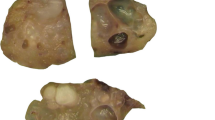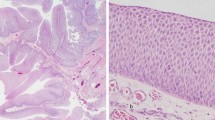Abstract
The sinonasal tract is a complex anatomic site with an exhaustive list of possible diagnoses. While most biopsies or resections encountered routinely consist of common diagnoses such as inflammatory polyps and papillomas, occasional cases are more difficult, and separating reactive or benign from malignancy can be challenging. One of the most poorly understood and daunting categories is low grade glandular or tubular proliferations, particularly on small biopsies. Possible diagnoses such as reactive lesions, respiratory epithelial adenomatoid hamartoma (REAH), seromucinous (glandular) hamartoma (SH) and low grade sinonasal adenocarcinomas (LGSNAC) must be entertained. REAH is composed of respiratory epithelial lined submucosal glands with variable connection to the surface and periglandular hyalinization. SH is a tubular proliferation reminiscent of normal serous glands which may be associated with REAH. LGSNAC is a diverse group of bland tubular and/or papillary tumors, which have a recurrence potential but an as yet uncertain potential for metastasis or mortality. The management for these lesions can be vastly different and conservative management is preferable, making this distinction more than academic. However, complicating this category are controversies surrounding their nature as reactive lesions versus neoplasms, the histologic and immunohistochemical overlap, and possible precursor relationships between some of them.






Similar content being viewed by others
References
Perez-Ordonez B. Hamartomas, papillomas and adenocarcinomas of the sinonasal tract and nasopharynx. J Clin Pathol. 2009;62(12):1085–95.
Franchi A, Gallo O, Santucci M. Clinical relevance of the histological classification of sinonasal intestinal-type adenocarcinomas. Hum Pathol. 1999;30(10):1140–5.
Wenig BM, Heffner DK. Respiratory epithelial adenomatoid hamartomas of the sinonasal tract and nasopharynx: a clinicopathologic study of 31 cases. Ann Otol Rhinol Laryngol. 1995;104(8):639–45.
Wenig BM. Respiratory epithelial adenomatoid hamartoma. In: Barnes L, Eveson JW, Reichart P, Sidransky D, editors. World Health Organization Classification of Tumours. Pathology and Genetics of Head and Neck Tumours. Lyon: IARC Press; 2005.
Weinreb I, Gnepp DR, Laver NM, et al. Seromucinous hamartomas: a clinicopathological study of a sinonasal glandular lesion lacking myoepithelial cells. Histopathology. 2009;54(2):205–13.
Ozolek JA, Barnes EL, Hunt JL. Basal/myoepithelial cells in chronic sinusitis, respiratory epithelial adenomatoid hamartoma, inverted papilloma, and intestinal-type and nonintestinal-type sinonasal adenocarcinoma: an immunohistochemical study. Arch Pathol Lab Med. 2007;131(4):530–7.
Flavin R, Russell J, Phelan E, et al. Chondro-osseous respiratory epithelial adenomatoid hamartoma of the nasal cavity: a case report. Int J Pediatr Otorhinolaryngol. 2005;69(1):87–91.
Roffman E, Baredes S, Mirani N. Respiratory epithelial adenomatoid hamartomas and chondroosseous respiratory epithelial hamartomas of the sinonasal tract: a case series and literature review. Am J Rhinol. 2006;20(6):586–90.
Ozolek JA, Hunt JL. Tumor suppressor gene alterations in respiratory epithelial adenomatoid hamartoma (REAH): comparison to sinonasal adenocarcinoma and inflamed sinonasal mucosa. Am J Surg Pathol. 2006;30(12):1576–80.
Green AJ, Sepp T, Yates JR. Clonality of tuberous sclerosis harmatomas shown by non-random X-chromosome inactivation. Hum Genet. 1996;97(2):240–3.
Jo VY, Mills SE, Cathro HP, et al. Low-grade sinonasal adenocarcinomas: the association with and distinction from respiratory epithelial adenomatoid hamartomas and other glandular lesions. Am J Surg Pathol. 2009;33(3):401–8.
Baillie EE, Batsakis JG. Glandular (seromucinous) hamartoma of the nasopharynx. Oral Surg Oral Med Oral Pathol. 1974;38(5):760–2.
Chuang SS, Lin CN. Microglandular adenosis arising in chronic paranasal sinusitis. Histopathology. 2000;36(4):376–7.
Zarbo RJ, McClatchey KD. Nasopharyngeal hamartoma: report of a case and review of the literature. Laryngoscope. 1983;93(4):494–7.
Graeme-Cook F, Pilch BZ. Hamartomas of the nose and nasopharynx. Head Neck. 1992;14(4):321–7.
Franchi A, Santucci M, Wenig BM. Adenocarcinoma. In: Barnes L, Eveson JW, Reichart P, Sidransky D, editors. World Health Organization Classification of Tumours. Pathology and Genetics of Head and Neck Tumours. Lyon: IARC Press; 2005.
Franquemont DW, Fechner RE, Mills SE. Histologic classification of sinonasal intestinal-type adenocarcinoma. Am J Surg Pathol. 1991;15(4):368–75.
Skalova A, Cardesa A, Leivo I, et al. Sinonasal tubulopapillary low-grade adenocarcinoma Histopathological, immunohistochemical and ultrastructural features of poorly recognised entity. Virchows Arch. 2003;443(2):152–8.
Author information
Authors and Affiliations
Corresponding author
Rights and permissions
About this article
Cite this article
Weinreb, I. Low Grade Glandular Lesions of the Sinonasal Tract: A Focused Review. Head and Neck Pathol 4, 77–83 (2010). https://doi.org/10.1007/s12105-009-0159-5
Received:
Accepted:
Published:
Issue Date:
DOI: https://doi.org/10.1007/s12105-009-0159-5




